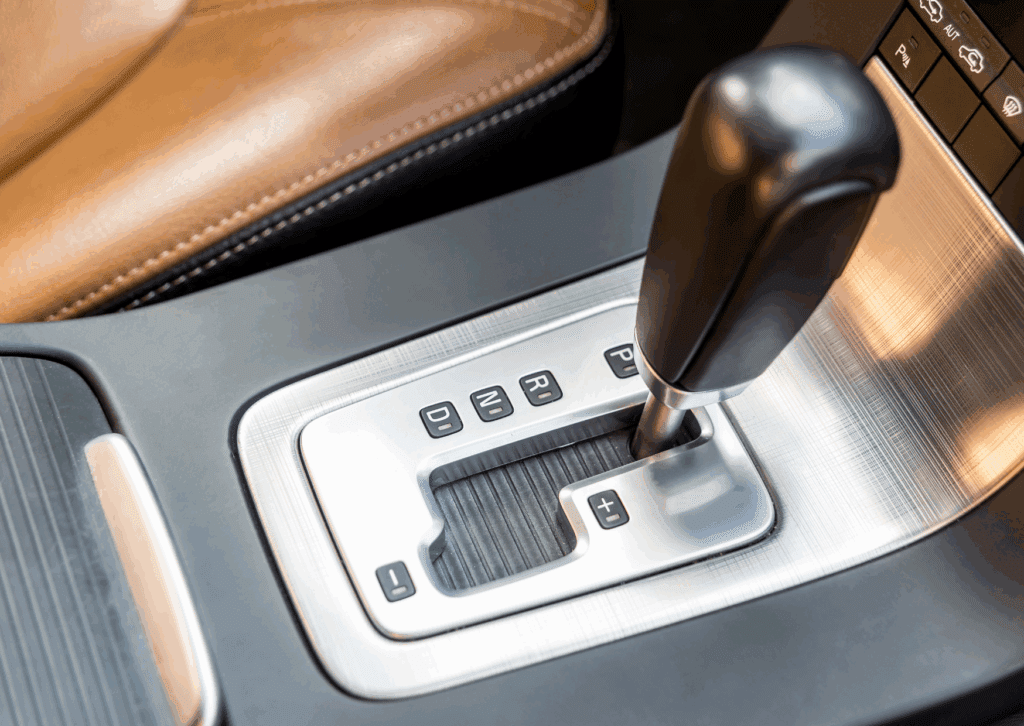A vehicle’s transmission is one of the most critical systems keeping your car moving smoothly. For many drivers, automatic transmission repairs can feel confusing and expensive, but knowing the basics helps prevent mistakes and costly repairs. Understanding how transmission fluid works, why routine maintenance matters, and when to schedule a transmission inspection can make the difference between a reliable vehicle and a broken-down car on the side of the road. This guide breaks down automatic transmission service in everyday language, so you know what to expect and when to act.
What Are Automatic Transmission Repairs?

Automatic transmission repairs are the processes and services performed to keep a car’s transmission system working properly. Unlike manual transmissions that rely on a clutch and driver control, an automatic transmission shifts gears automatically using fluid pressure, a torque converter, and transmission parts like gears and valves.
Automatic transmission repairs can include:
- Transmission fluid change or flushes
- Replacing a pan gasket or installing a new pan gasket to stop leaks
- Adjusting or replacing transmission parts such as solenoids or sensors
- Transmission inspection for leaks, noise, or debris
- Full transmission rebuilds or replacement if major transmission problems occur
When a vehicle’s transmission system begins to fail, even the engine can feel the strain, leading to poor performance, noise, and safety concerns.
How Does an Automatic Transmission Work?

An automatic transmission uses hydraulic pressure and transmission fluid to transfer power from the engine to the wheels. Instead of a manual clutch, the torque converter handles the connection between the engine and the transmission system, allowing smooth gear changes without driver input.
Key features of automatic transmissions:
- Torque converter: Replaces the clutch found in manual transmissions.
- Gears: Automatically selected based on speed and load.
- Transmission fluid: Keeps transmission parts cool, lubricated, and clean.
- Control system: Modern vehicles often include a computer that monitors performance and adjusts shifting.
Some vehicles also use a continuously variable transmission (CVT), which operates differently but still requires routine maintenance and transmission service.
Why Is Transmission Fluid So Important?

Transmission fluid is the lifeblood of the transmission system. Without clean transmission fluid, gears grind, the torque converter overheats, and debris builds up, leading to costly repairs.
Functions of transmission fluid include:
- Lubricating moving transmission parts
- Cooling the system and reducing heat buildup
- Carrying away debris and keeping the system clean
- Supporting hydraulic pressure is needed to shift gears
A transmission fluid change or automatic transmission fluid exchange ensures the system has clean fluid to operate efficiently. Using old fluid too long is one of the most common mistakes drivers make.
What Is an Automatic Transmission Fluid Exchange?

An automatic transmission fluid exchange is a process where old fluid is removed and new fluid is introduced into the system. Unlike a simple drain-and-fill, which replaces only some of the fluid, a fluid exchange circulates through the system to ensure clean fluid fills the entire transmission.
Benefits of a fluid exchange:
- Replaces nearly all old fluid with new fluid
- Helps remove debris and sludge from the system
- Improves efficiency and prolongs the life of the transmission
- Can prevent transmission problems before they begin
In some cases, a transmission flush may also be recommended. Both services require proper equipment and expert technicians to perform the job correctly.
How Do Manual Transmissions Differ from Automatic Transmissions in Maintenance?

While automatic transmission repairs focus on fluid, torque converters, and hydraulic systems, manual transmissions operate differently.
Manual transmissions use:
- A clutch pedal controlled by the driver
- Mechanical gear shifting rather than automatic systems
- Less fluid compared to automatics
Maintenance needs:
- Manual transmissions require clutch replacement on a regular basis, depending on wear.
- Automatic systems rely more heavily on fluid changes, inspections, and pan gasket replacements.
Both systems need transmission service, but automatic transmission repairs typically involve more labor, higher cost, and advanced equipment.
What Is a Transmission Service, and Why Does It Matter?

A transmission service is part of routine maintenance that involves checking and servicing the car’s transmission to keep it running efficiently.
A full service may include:
- Draining and replacing transmission fluid
- Installing a new pan gasket if leaks are found
- Transmission inspection for debris, noise, or overheating
- Checking the torque converter and transmission parts
- Ensuring shifting performance is smooth and efficient
Regular service helps avoid costly repairs, gives customers peace of mind, and ensures the car’s transmission stays reliable over time. Skipping this service is a common mistake that leads to unexpected transmission problems.
When Should You Get a Transmission Fluid Change?

Transmission fluid changes should be scheduled on a regular basis, depending on the vehicle and manufacturer guidelines.
General guidance:
- Every 30,000 to 60,000 miles for most vehicles
- More often, if you drive in stop-and-go traffic, tow heavy loads, or experience frequent heat buildup
- Immediately inspect if you notice a burning smell, slipping gears, or a check engine light
A transmission check can determine whether the fluid is clean or contaminated. If the fluid appears dark, has debris, or smells burnt, it’s time for new fluid.
What Are the Signs of Transmission Problems?

Catching transmission problems early helps avoid costly repairs and keeps your vehicle safe.
Common warning signs include:
- Check the engine light on the dashboard
- Grinding or whining noise during acceleration
- Difficulty shifting gears or delayed engagement
- Transmission fluid is leaking under the car
- Burning smell caused by overheated fluid
- Slipping gears or loss of power
If you notice these symptoms, schedule a transmission inspection with expert technicians immediately. Waiting too long can turn a minor repair into a major replacement job.
Why Is Professional Transmission Repair Essential?

Transmission repair is not a simple job. Automatic transmission repairs involve specialized tools, knowledge, and equipment to access and replace parts correctly.
Professional service ensures:
- Accurate diagnosis of transmission problems
- Safe and efficient fluid exchange or replacement
- Proper installation of a new pan gasket, torque converter, or other transmission parts
- Access to expert technicians and high-quality equipment
- Nationwide warranty protection is offered by many professional shops
Trying to handle a transmission flush or fluid exchange without training can cause damage, costing more in labor and replacement later.
Ready for Professional Automatic Transmission Repairs?

If your car’s transmission is slipping, leaking, or triggering the check engine light, it’s time for expert help. The trained team at Metric Motors provides full automatic transmission repairs, from routine maintenance and transmission fluid changes to full diagnostics and replacements. With experienced technicians, proper equipment, and a focus on customer care, Metric Motors can keep your vehicle’s transmission reliable, efficient, and safe. Don’t wait until small issues turn into costly repairs; schedule your transmission service today. Book an appointment today!
Final Thoughts on Why Automatic Transmission Repairs Matter
Automatic transmission repairs are one of the most important parts of vehicle maintenance. Clean fluid, regular inspections, and timely transmission service keep the car’s transmission running smoothly and prevent expensive breakdowns. From fluid changes and pan gasket replacements to diagnosing torque converter or gear problems, the right service protects your car, your engine, and your peace of mind. By acting early and trusting expert technicians, you can expect reliable performance, efficient driving, and a safer ride.
Works Cited
AAA. “Transmission Maintenance and Repair.” AAA Exchange, https://exchange.aaa.com/automotive/transmission-maintenance-repair/. Accessed 21 Aug. 2025.
National Highway Traffic Safety Administration. “Vehicle Maintenance: Transmission Systems.” NHTSA, https://www.nhtsa.gov/equipment/transmission. Accessed 21 Aug. 2025.
U.S. Department of Energy. “Keeping Your Vehicle in Shape.” Energy.gov, https://afdc.energy.gov/files/u/publication/keeping_vehicle_in_shape.pdf. Accessed 21 Aug. 2025.
Society of Automotive Engineers. “Transmission Systems and Fluid Exchanges.” SAE International, https://www.sae.org/publications/technical-papers/transmission. Accessed 21 Aug. 2025.
Consumer Reports. “When Do You Need a Transmission Fluid Change?” Consumer Reports, https://www.consumerreports.org/cars/car-maintenance/transmission-fluid-change/. Accessed 21 Aug. 2025.
Frequently Asked Questions
What do automatic transmission repairs usually include?
Automatic transmission repairs can involve a transmission fluid change, transmission flushes, installing a new pan gasket, replacing worn transmission parts, or even a full rebuild depending on the problem.
How often should I schedule a transmission fluid change?
Most vehicles need a transmission fluid change every 30,000 to 60,000 miles. However, driving in stop-and-go traffic, towing, or frequent heat exposure may require more frequent service.
What are the signs of transmission problems?
Warning signs include slipping gears, unusual noise, leaking fluid, a burning smell, or the check engine light turning on. Any of these should prompt a transmission inspection right away.
Why is transmission fluid so important?
Transmission fluid lubricates gears, cools the transmission system, and removes debris. Clean transmission fluid helps prevent costly repairs and keeps the vehicle’s transmission efficient.
Should I attempt transmission repair myself?
No. Automatic transmission repairs require expert technicians, proper equipment, and training. DIY mistakes can lead to unsafe driving conditions and more expensive replacement jobs later.





